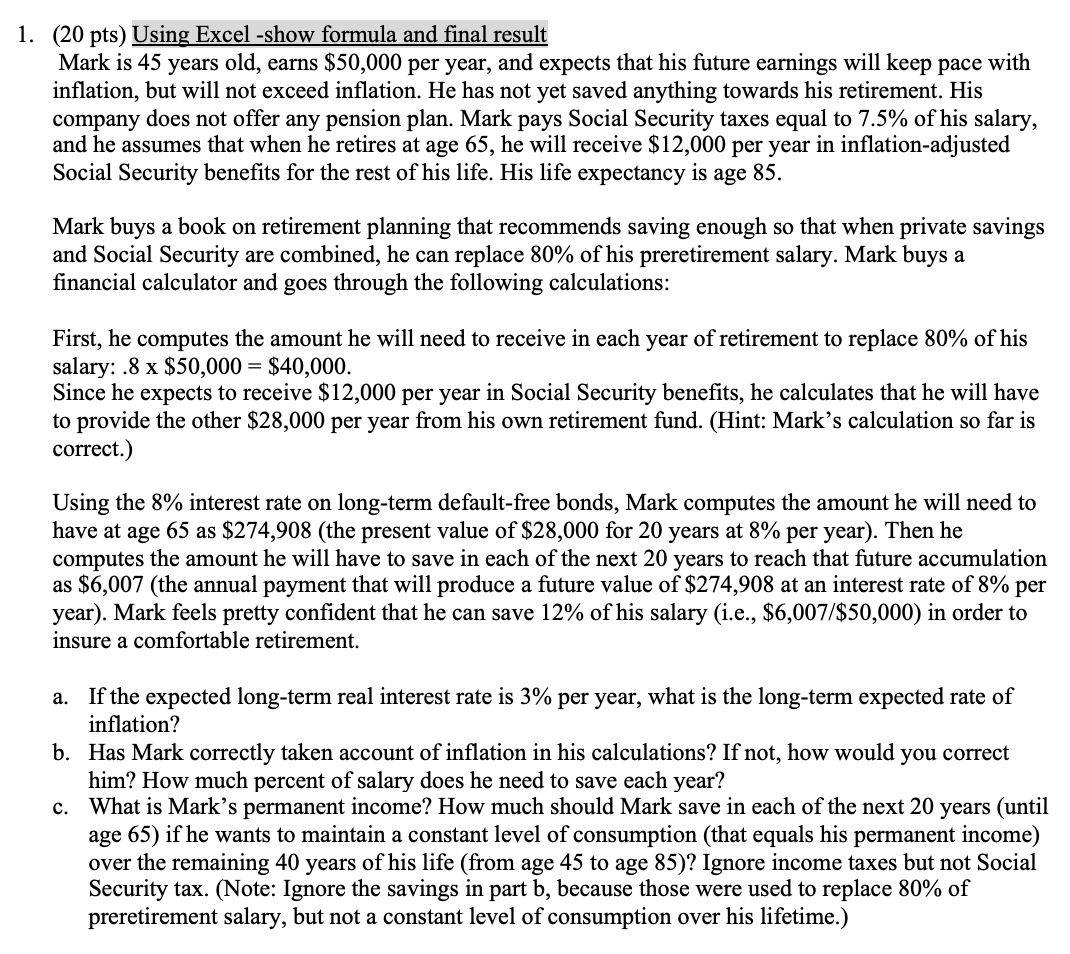
1. (20 pts) Using Excel -show formula and final result Mark is 45 years old, earns $50,000 per year, and expects that his future earnings will keep pace with inflation, but will not exceed inflation. He has not yet saved anything towards his retirement. His company does not offer any pension plan. Mark pays Social Security taxes equal to 7.5% of his salary, and he assumes that when he retires at age 65, he will receive $12,000 per year in inflation-adjusted Social Security benefits for the rest of his life. His life expectancy is age 85. Mark buys a book on retirement planning that recommends saving enough so that when private savings and Social Security are combined, he can replace 80% of his preretirement salary. Mark buys a financial calculator and goes through the following calculations: First, he computes the amount he will need to receive in each year of retirement to replace 80% of his salary: .8 x $50,000 = $40,000. Since he expects to receive $12,000 per year in Social Security benefits, he calculates that he will have to provide the other $28,000 per year from his own retirement fund. (Hint: Mark's calculation so far is correct.) Using the 8% interest rate on long-term default-free bonds, Mark computes the amount he will need to have at age 65 as $274,908 (the present value of $28,000 for 20 years at 8% per year). Then he computes the amount he will have to save in each of the next 20 years to reach that future accumulation as $6,007 (the annual payment that will produce a future value of $274,908 at an interest rate of 8% per year). Mark feels pretty confident that he can save 12% of his salary (i.e., $6,007/$50,000) in order to insure a comfortable retirement. a. If the expected long-term real interest rate is 3% per year, what is the long-term expected rate of inflation? b. Has Mark correctly taken account of inflation in his calculations? If not, how would you correct him? How much percent of salary does he need to save each year? c. What is Mark's permanent income? How much should Mark save in each of the next 20 years (until age 65) if he wants to maintain a constant level of consumption (that equals his permanent income) over the remaining 40 years of his life (from age 45 to age 85)? Ignore income taxes but not Social Security tax. (Note: Ignore the savings in part b, because those were used to replace 80% of preretirement salary, but not a constant level of consumption over his lifetime.) 1. (20 pts) Using Excel -show formula and final result Mark is 45 years old, earns $50,000 per year, and expects that his future earnings will keep pace with inflation, but will not exceed inflation. He has not yet saved anything towards his retirement. His company does not offer any pension plan. Mark pays Social Security taxes equal to 7.5% of his salary, and he assumes that when he retires at age 65, he will receive $12,000 per year in inflation-adjusted Social Security benefits for the rest of his life. His life expectancy is age 85. Mark buys a book on retirement planning that recommends saving enough so that when private savings and Social Security are combined, he can replace 80% of his preretirement salary. Mark buys a financial calculator and goes through the following calculations: First, he computes the amount he will need to receive in each year of retirement to replace 80% of his salary: .8 x $50,000 = $40,000. Since he expects to receive $12,000 per year in Social Security benefits, he calculates that he will have to provide the other $28,000 per year from his own retirement fund. (Hint: Mark's calculation so far is correct.) Using the 8% interest rate on long-term default-free bonds, Mark computes the amount he will need to have at age 65 as $274,908 (the present value of $28,000 for 20 years at 8% per year). Then he computes the amount he will have to save in each of the next 20 years to reach that future accumulation as $6,007 (the annual payment that will produce a future value of $274,908 at an interest rate of 8% per year). Mark feels pretty confident that he can save 12% of his salary (i.e., $6,007/$50,000) in order to insure a comfortable retirement. a. If the expected long-term real interest rate is 3% per year, what is the long-term expected rate of inflation? b. Has Mark correctly taken account of inflation in his calculations? If not, how would you correct him? How much percent of salary does he need to save each year? c. What is Mark's permanent income? How much should Mark save in each of the next 20 years (until age 65) if he wants to maintain a constant level of consumption (that equals his permanent income) over the remaining 40 years of his life (from age 45 to age 85)? Ignore income taxes but not Social Security tax. (Note: Ignore the savings in part b, because those were used to replace 80% of preretirement salary, but not a constant level of consumption over his lifetime.)







